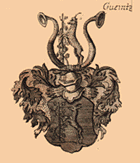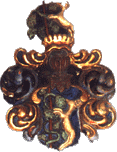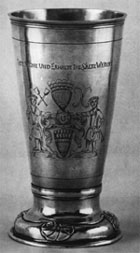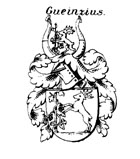About the Coat of Arms of our Family |
Updated: 02/24/2010 |
||||
| Our family is possessing a coat of arms already over 350 years as can be proved. It shows on a blue shield and on a green ground a yellow roebuck which is climbing on a grapevine. On a helmet with blue-yellow cover is standing the shield figure between two over the corner blue-yellow inked buffalo horns. - The latter has been left over some times. In former times the figure looks more like a he-goat than a roebuck. | About coat of arms | ||||
| The first time we find the coat of arms was on a letter from 1629 of the Magister Christian Gueintz to be found in the archives of the city of Halle; it carries the writing "Christian Gueinzius" and consist at that times already of the buffalo horns. |
|
||||
| His both sons and their descendants used it very often in letters and until 1777 it is to be found in the documents of their feoff where the agnates (blood relatives) attested their signature with their seal. That is the reason why we have got 12 different seals out of that times. The seals were changed very often and of course were left to the inherits. Today the most of us have got their coat of arms at their confirmation mostly as a signet-ring. |
 |
||||
| But in churches and on tombs we find the coat of arms as well. In churches the coat of arms were placed by the patron (donator of a church with the special right to suggest the new pastor) who were married with a Gueinzius born wife. To be seen in Osterhausen (Saxony-Anhalt), two times in the Godoberti church at Markt Alvensleben (renamed in Bebertal in the times of the GDR, Saxony-Anhalt), then in the church at Nordgermersleben (Saxony-Anhalt). The booth latter churches have been patronage churches of the Wißmann family. |
 |
||||
| At least there is one on the former tomb arch No. 9 on the Stadtgottesacker in the city of Halle (Saxony-Anhalt), where it was destroied at the end of World War II on March 31, 1945 by a bomb attack, and more and at the Ulrichs church at Halle, where it was removed years before. | Homepage of the city of Halle at the Saale river | ||||
| Further on we find the coat of arms on a silver cup which Christoph Johann Gottfried Ernst Gueinzius - 5621 - (1725 - 1786) gave to the Salzwirkerbrüderschaft (brotherhood of salt weavers) as he inaugurated into the duty of salt lord on August 7, 1769. Today the silver cup is part of the Hallorenschatz (special treasure of the brotherhood of salt weavers in Halle) deposited in the Halloren- und Salinemuseum (museum for saltworks). It is a really pretty workmanship and regularly presented together with the whole silver treasure of the Halloren. |
 |
||||
| In the 19th century, the coat of arms was used predominantly for the credit and was printed on writing paper or worn on a signet ring. In knowledge about the tinctures of the coat of arms was lost in the family. Only Richard - HH 1 - (1875 - 1939) familiarized himself with heraldry and "rediscovered" the tinctures. |
Picture of a seal press
Picture of a signet ring |
||||
| It was also he who had registered the coat of arms in "Johann Siebmacher's Wappenbüchern" (coat of arms books). There we find it in the volume V, middle class sexes, section 7, on board 6. |
 |
||||
|
About origin of the coat of arms nothing is confessed. Richard (1875 - 1939) assumed that the draft goes back to Christian (1592 - 1650) who has used it for the first time as we know. He explained by the fact that Christian often used the biblical parable "I am the vinestock and you are the grapes". For Neubecker [1], the vinestock however actual is only accessory and the coat of arms figure is the roebuck. Literature:
|
 |
||||